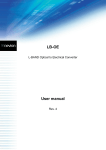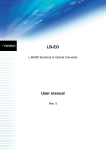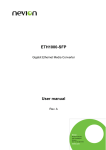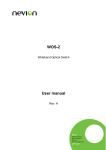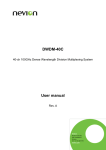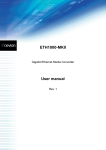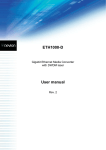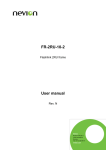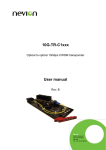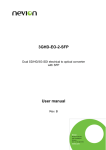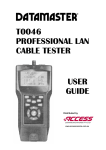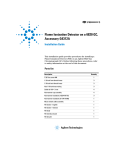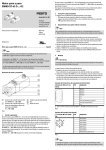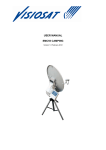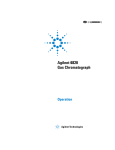Download LB-OE User manual
Transcript
LB-OE L-BAND Optical to Electrical Converter User manual Rev. E Nevion Nordre Kullerød 1 3241 Sandefjord Norway Tel: +47 33 48 99 99 nevion.com LB-OE Rev. E Nevion Support Nevion Europe Nevion USA P.O. Box 1020 3204 Sandefjord, Norway Support phone 1: +47 33 48 99 97 Support phone 2: +47 90 60 99 99 1600 Emerson Avenue Oxnard, CA 93033, USA Toll free North America: (866) 515-0811 Outside North America: +1 (805) 2478560 E-mail: [email protected] See http://www.nevion.com/support/ for service hours for customer support globally. Revision history Current revision of this document is the uppermost in the table below. Rev. Repl. Date Sign E 4 2015-05-12 MB 4 3 2011-02-21 AA 3 2 2008-04-01 GMW 2 1 2007-11-01 GMW 1 0 2007-09-25 GMW 0 A A - 2007-03-29 2006-05-01 GMW GMW Change description Cover page update. Removed Declaration of Conformity. No other changes to content. New template. Updated Declaration of Conformity. Removed Chapter 2.5 (Environmental conditions). Added connector interface description and more application details in product overview. Added Declaration of Conformity. Changed maximum optical input from 0dBm to -3dBm Changed optical budget to 16dB for 15T/CWDM and 6dB for 13T First official version Preliminary version nevion.com | 2 LB-OE Rev. E Contents Revision history ......................................................................................................................2 1 Product overview .................................................................................................................4 2 Specifications ......................................................................................................................6 2.1 RF Characteristics ............................................................................................................6 2.2 LNB Power Connector ......................................................................................................6 2.3 Optical Characteristics......................................................................................................6 2.4 Power consumption ..........................................................................................................6 3 Configuration .......................................................................................................................7 3.1 Format configuration ........................................................................................................7 4 Connections ........................................................................................................................8 4.1 Mounting the connector module .......................................................................................8 4.2 Terminal format support ...................................................................................................9 5 Module status .................................................................................................................... 10 5.1 GPI Alarm – Module status outputs ................................................................................ 10 5.2 Front panel – Status monitoring ...................................................................................... 11 6 Laser safety precautions ................................................................................................... 12 General environmental requirements for Nevion equipment ................................................. 13 Product Warranty ................................................................................................................. 14 Appendix A Materials declaration and recycling information ................................................. 15 A.1 Materials declaration ...................................................................................................... 15 A.2 Recycling information ..................................................................................................... 15 nevion.com | 3 LB-OE Rev. E 1 Product overview The Flashlink LB-OE is an optical to electrical converter module providing high performance media conversion for analogue signals with bandwidth from 950 to 2150 MHz. This state of the art unit offers a high sensitivity PIN diode technology followed by amplifiers with low noise, low distortion and capable of amplifying large signal levels. The attenuator is a high performance digitally controlled device, giving low distortion and flat frequency response. The LB-OE is therefore the first choice for all optical transport demands on L-band. The LB-OE together with LB-EO, can transport all L-band signals between 950 and 2150 MHz over large distances using fiber optical transport media. The optical input comes with a sophisticated wideband PIN diode with a sensitivity typically better than – 20dBm operating in the 2nd and 3rd optical windows. The open system platform of Network Electronics Flashlink system allows easy interoperability with third party fiber optical systems. There is also an attenuated monitor output for test and service purposes as well as a remote control interface. Figure 1: LB-OE L-band O/E converter. This L-band link is normally used in conjunction with other equipment like satellite tuners, LNBs in parabolic dishes etc, and the link performance is dependant of good signal to noise ratio from the signal source and good noise figure of the receiver equipment. The link quality is also dependant of the number of channels transferred on the link. For instance, the link’s signal to noise ratio is reduced with 3dB when doubling the number of the channels (twice the power). An optical link will add some noise to the signal. The amount of noise is dependant of the fiber loss, the satellite receiver sensitivity, number of channels and the total power level of the signal. The combination if analogue and digital satellite signals is also important. Many analogue satellite signals (which tend to have higher power), will reduce the signal to noise ratio on the digital signals. This is because the link’s power must be reduced according to the total power of the link. Noise figure of the link is a number usually in dB that states how much the signal to noise ratio (S/N ratio) is reduced from the input to the output. If the S/N ratio from the dish is X dB, the noise figure on the link is Y dB, the S/N ratio on the output will be X-Y dB. Dependant on the application (fiber loss, total power on signal and power of the laser), one link will typically add 4-5dB noise for fiber distances less than 3000 meters. A coaxial cable will attenuate more on higher frequencies than lower. If the attenuation on 2GHz is more than the noise figure for the L-band link, there will be a system nevion.com | 4 LB-OE Rev. E improvement regarding total signal to noise ratio. Therefore, to distance from the dish to the receiver must be significant (more than 200 meters, dependant of the coaxial cable specification) for getting return of the investment of the L-band link. If the application needs galvanic isolation, the L-band link is a very good way to achieve this functionality. nevion.com | 5 LB-OE Rev. E 2 Specifications 2.1 RF Characteristics Frequency band width Return loss RF interface Monitor interface Gain flatness Maximum output signal Inter modulation products Link gain Optical link budget 1dB compression (output) Noise figure Carrier to noise ratio (CNR) Spurious free dynamic range (SFDR) (typically -25dBm) 950-2150 MHz >10dB F-connector BNC (attenuated signal for connection to spectrum analyzer) ±1.5dB over entire band ±0.25dB at any 36 MHz > -5dBm < -55dBc with two carriers –20dBm input signal, 5dB fiber loss 40dB 16dB/50km (with LB-EO-15T/LB-EO-C1xxx) 6dB (with LB-EO-13T) 0dBm <10dB @ 3dB fiber optical loss <20dB @ 16dB fiber optical loss >45dB with maximum input power @ 36MHz (with LB-EO15T/LB-EO-C1xxx) >35dB with maximum input power @ 36MHz (with LB-EO13T) >110dBc/Hz 2.2 LNB Power Connector Power connector Not used on LB-OE 2.3 Optical Characteristics Wavelength 1270-1610 nm Maximum input power -3 dBm Optical interface SC/UPC, Single mode 2.4 Power consumption Maximum power consumption: <3W (+5V) <1.5W (-15V) <1.5W (+15V) nevion.com | 6 LB-OE Rev. E 3 Configuration 3.1 Format configuration The LB-EO can be used in different user application, depending on the user wants automatic gain control, fixed gain or automatically adjusted once and then fixed. The correct configuration can either be set with a DIP switch or with the GYDA Control System. The layout of LB-EO is shown in the drawing below with the DIP switch to the upper left position. Figure 2: LB-OE board layout. DIP switch configuration must be set according to the table below: Switch # Label 1 AGC 2 R/S 3 4 5 6 7 8 OVR Function, DIP = ON Automatic gain control Run AGC Override GYDA control. Config. with DIP switch Function, DIP = OFF Manual gain control Sample AGC level GYDA control. Config. with GYDA Comment Only valid in Automatic gain control mode Not used Not used Not used Not used Not used Select configuration from GYDA All DIP switches are off when pointing towards the release handle. nevion.com | 7 LB-OE Rev. E 4 Connections The Flashlink LB-OE has a dedicated connector module: LB-EO-C1. This module is mounted at the rear of the sub-rack. The module is shown in the figure below. Monitor output Fiber optical RF input LNB power supply GPI Figure 3: Connector module for L-band. In typical use, an LB-EO / LB-OE module at each end will be used. An LNB is connected to the F-connector of the LB-EO, and a satellite tuner is connected to the Fconnector of the LB-OE. The voltage/22kHz output from the satellite tuner, cannot be transferred on the fiber between LB-EO and LB-OE, because this signal goes the other way. The LB-OE can nevertheless detect voltage and/or tone, and put them to the GPI output on the LB-OE. Using a separate communication line (two digital signals using D422MG or similar), these signals can be transferred to the LB-EO. Another alternative is controlling the LB-EO directly using either Gyda or GPI inputs. The LB-OE will always detect the voltage/tone from the satellite tuner or other equipment, and set the GPI according to the detected tone and voltage. A 22 kHz tone on top of the LNB power supply indicates high band (11.7-12.75 GHz) and no tone is for low band (10.7-11.7 GHz). Vertical polarization is chosen with a voltage less than 15 volts, typically 13 volts. Most LNBs will set vertical polarization within a voltage window (for instance from 11.5 to 14.2 volts dependant of the LNB). Accordingly the horizontal polarisation is voltage greater than 15 volts, typically 18 volts (for instance from 15.8 to 19.0 volts). If the voltage is near 15 (for instance between 14.2 and 15.8), the polarization will be uncertain. The example voltages are LNB manufacturer dependant; please check the user manual for the LNB voltage thresholds. 4.1 Mounting the connector module The details of how the connector module is mounted, is found in the user manual for the sub-rack frame FR-2RU-10-2. This manual is also available from our web site: http://www.nevion.com/ nevion.com | 8 LB-OE Rev. E 4.2 Terminal format support The different input and output ports on LB-OE can support a number of formats. The table below shows which signal formats are supported on the selected terminals. Terminal format support: Terminal OPT Function Optical Input RF Electrical Output GPI Output Control High/low band and polarity Data Input Open Collector Alarms GPI Input GPI ALARM Supported Format Analogue 950-2150 MHz Analogue 950-2150 MHz Digital Output Digital Input Wired alarms Mode Input Output Output CMOS Input OC Output nevion.com | 9 LB-OE Rev. E 5 Module status The status of the module can be monitored in three ways. 1. GYDA System Controller (optional). 2. GPI at the rear of the sub-rack. 3. LED’s at the front of the sub-rack. Of these three, the GPI and the LED’s are mounted on the module itself, whereas the GYDA System Controller is a separate module giving detailed information on the card status. The functions of the GPI and the LED’s are described in sections 5.1 and 5.2. The GYDA controller is described in a separate user manual. 5.1 GPI Alarm – Module status outputs These outputs can be used for wiring up alarms for third party control systems. The GPI outputs are open collector outputs, sinking to ground when an alarm is triggered. The GPI connector is shown in figure below. LB-OE module GPI pinning: Figure 4: GPI output. Signal Status LOS LEVEL H/L H/V DATA Name General error status for the module (open = alarm) Loss of Signal (open = signal detected) Input level too high Band select (open = low band = no tone) Polarity horizontal/vertical (open = horizontal = high voltage) Data input Ground 0 volt pin Electrical Maximums for GPI outputs: Pin # Pin 1 Mode Open Collector Pin 2 Pin 3 Pin 4 Pin 5 Open Collector Open Collector Open Collector Open collector Pin 6 CMOS Input (Threshold at 2.5V) 0V. Pin 8 Max current: 100mA Max voltage: 30V nevion.com | 10 LB-OE Rev. E 5.2 Front panel – Status monitoring The status of the module can be easily monitored visually by the LED’s at the front of the module. The LED’s are visible through the front panel as shown in the figure below. Figure 5: Front panel indicators for the LB-OE. The LB-OE has 4 LED’s each showing a status corresponding to the GPI pinning. Diode \ State STATUS LOS LEVEL Red LED Module is faulty, or module is initializing. No signal Signal level too high – increase attenuation or reduce input level Green LED Module is OK Module power is OK Signal is present Orange LED Signal level critical - increase attenuation or reduce input level No light Module has no power Module has no power Signal level not critical nevion.com | 11 LB-OE Rev. E 6 Laser safety precautions These are guidelines to limit hazards from laser exposure. All the available EO units in the Flashlink range include a laser. Therefore this note on laser safety should be read thoroughly. The lasers emit light at wavelengths from 1270nm up to 1610nm. This means that the human eye cannot see the beam, and the blink reflex cannot protect the eye. (The human eye can see light between 400 nm to 700 nm). A laser beam can be harmful to the human eye (depending on laser power and exposure time). Therefore: Be careful when connecting / disconnecting fiber pigtails (ends). Never look directly into the pigtail of the laser/fiber. Never use microscopes, magnifying glasses or eye loupes to look into a fiber end. Use laser safety goggles blocking light at 1310 nm and at 1550 nm Instruments exist to verify light output power: Power meters, IR-cards etc. Flashlink features: All the laser module cards in the Flashlink product range, are Class 1 laser products according to IEC 825-1 1993, and class I according to 21 CFR 1040.10 when used in normal operation. More details can be found in the user manual for the FR-2RU-10-2 frame. Maximum output power1: 5 mW Operating wavelengths: > 1270 nm 1 Max power is for safety analysis only and does not represent device performance. nevion.com | 12 LB-OE Rev. E General environmental requirements for Nevion equipment 1. 2. - The equipment will meet the guaranteed performance specification under the following environmental conditions: Operating room temperature 0°C to 40°C range: Operating relative humidity range: <90% (non-condensing) The equipment will operate without damage under the following environmental conditions: Temperature range: -10°C to 55°C Relative humidity range: <95% (non-condensing) nevion.com | 13 LB-OE Rev. E Product Warranty The warranty terms and conditions for the product(s) covered by this manual follow the General Sales Conditions by Nevion, which are available on the company web site: www.nevion.com nevion.com | 14 LB-OE Rev. E Appendix A Materials declaration and recycling information A.1 Materials declaration For product sold into China after 1st March 2007, we comply with the “Administrative Measure on the Control of Pollution by Electronic Information Products”. In the first stage of this legislation, content of six hazardous materials has to be declared. The table below shows the required information. Toxic or hazardous substances and elements 組成名稱 Part Name LB-OE 鉛 汞 镉 六价铬 多溴联苯 Lead Mercury Cadmium Hexavalent Polybrominated (Pb) (Hg) (Cd) Chromium biphenyls (Cr(VI)) (PBB) O O O O O 多溴二苯醚 Polybrominated diphenyl ethers (PBDE) O O: Indicates that this toxic or hazardous substance contained in all of the homogeneous materials for this part is below the limit requirement in SJ/T11363-2006. X: Indicates that this toxic or hazardous substance contained in at least one of the homogeneous materials used for this part is above the limit requirement in SJ/T11363-2006. This is indicated by the product marking: A.2 Recycling information Nevion provides assistance to customers and recyclers through our web site http://www.nevion.com/. Please contact Nevion’s Customer Support for assistance with recycling if this site does not show the information you require. Where it is not possible to return the product to Nevion or its agents for recycling, the following general information may be of assistance: Before attempting disassembly, ensure the product is completely disconnected from power and signal connections. All major parts are marked or labeled to show their material content. Depending on the date of manufacture, this product may contain lead in solder. Some circuit boards may contain battery-backed memory devices. nevion.com | 15
















